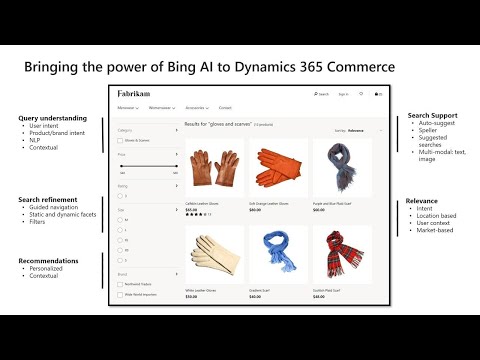Transforming the way retailers do business online | BRK1085

Hello. Everyone. Welcome. To what. I'm guessing is your last, session, for, ignite. So. For those of you who are still here Wow well done like, you hope you were really you're you you, are the power session. Ares and that, you were here on day five to. Hear us talk and for those of you who are watching the video afterwards. We're. Really glad that you're tuning in as well, my. Name is Brian King. I'm with, the Bing Products global ecosystem, team and. We're gonna talk about, transforming. The way retailers, do business online and, we're. Going to talk a bit about search, today we're going to talk about, recommendations. We're going to talk about dynamics. Commerce, 365. Okay. So. Retail. Is really. Really evolving, and it has been for the last few years but. It's more and more it's turning into a, curated. Experience that. Starts, with the user at home. To. When, they start walking, in that door to. Experiences. That they might have in the, store we're a reimagining, retail. And how visual. Dimensions, are coming into play and allowing, me to think about what. Works for me how, can I see, my personal preferences. To. Helping. The associate, in the store find, that thing how many of us have gone into a store and said you. Know I really want this but I needed two sizes bigger and I need it in, navy and, they. May or may not know that that product catalog well all. The way through to the logistics, you. Might be buying something online and you need to troll filled I might be buying something in a store and I, want to make sure that it gets shipped to me and then, for, those of us who are you, know really really trying to drive those, sales, and that revenue, in that back, office afterwards, how, are we using that data to ensure that we're, getting the, most from. Our customers, and providing, the most for our customers. So. As we've. Been going through this journey and talking, to a lot of the large retailers out there, from. A Kiplinger report last August. You know ecommerce, growth, is five, times higher versus. In-store that, doesn't, include. Autos. Just. To to. Make sure make sure that's clear.
Seventy-five. Percent of retailers rank ecommerce. Is a top priority and those who don't are. Typically, more focused, on brick and mortar and don't see an online space for them so you could really say that anyone, who has the opportunity to have an online space sees that as a top priority and then, 51, percent, of online retail. Is is existing. Outside the market leader. Now. Modern. Websites today really. Require, a modern. Search, how. Many of you have experienced. Going, to a website and searching for something and not being able to find it and what do you do, thank. You for those of you but of your hands many of you you. Vote with your feet right you go somewhere else or I guess you vote with your mouse you click somewhere else and you you, search and, oftentimes. You don't go back to that Erie Taylor because. They're. Just not able to meet your need you're not able to complete that task and, you're not able to do it quickly so, 80%, of shoppers will abandon a site that produces, poor results according to that Business Insider a report I'm wondering what the other 20, are doing and they must be still on that site and pretty frustrated, but, in either way we, can certainly help them and we're going to talk about that today we're. Going to talk about that and we're gonna talk about how in doing so you. Can maximize, your, revenue, revenue. That many. Retailers. Are leaving on the table today. Because. They're not monetizing. Aspects. Of their search that, we'll talk about now. The. Challenge, would current, search capabilities. That are in use today and, I'm, talking, to all of you out there who are using the, solar and, the elastic, type searches, is that, if we take this nice bottle of contoso, Cabernet. Sauvignon, it's a great vintage I guarantee, you and we. Put that in our index so we, put that in our castle store. Today. We probably store it with the title and the description and. You. Know a little bit of additional. Maybe metadata, around that, the. Trouble is that that's. All the searches, of today are really relying, on so when, Maria, who's, here, she's planning a nice evening with. Her friends, and she's. Already got the salad so she's thinking healthy, good it's good for me too and, she's. In the Pacific Northwest so of course there has to be some salmon. But, she's thinking about what, kind of wine should I have you know I wants to be kind of nice I wanted to pair with the salmon, would, be really good so she, goes and does a search query for wine.
That, Pairs well. With salmon, no the only problem is that with, today's search engines, they. Don't understand. That intent and the kind of results that you'll get today on some major retailers. Is you'll get locked back lots of salmon, because. That's something that that. That resonates or, has a lot of items, in the catalog, and, it's that the key here is that the, intent, is not being understood so. The fact that we're talking about paring, something. With something else is, not, being understood so. That that. Results, in, lower. Revenue, and, we've. Seen through, work that we've done with major retailers that. That's leaving about. 30%, revenue on the table because people are not finding things and they're going elsewhere. The. Problem gets worse though, the, problem gets worse because Pablo. The. Developer, at that retailer is now, taking, that information looking. At that logs figuring. Out okay. So we. Didn't convert that one why didn't we convert that one there's, investigations. That happen and many. Of you and many retailers I talked to would probably. Understand. What I say when when I said that the developers, start adding synonyms. So. You start adding synonyms, and you start saying okay so I, need a synonym, wine, and salmon, or maybe pairing, but, the trouble with synonyms, with, current search technology, is that they're, not contextually. Aware so, now I could start typing in salmon and maybe start getting back paring knives and. Now I'm playing Wacka so, I add a synonym, here and other problems created here I try to change that and so on so forth I have. To stop being aggressive with my mic here it doesn't like when I do that so, this this creates a huge headache and it increases, the cost total. Cost of ownership for, you meant managing, and maintaining your, your site, so. The. Reason, that this is happening is, because the. Current search engines. Today do, not have that intent understanding. They, don't do query, classification. And their. Search isn't, self, learning, because. Wouldn't it be great if. Every. Time one of my customers, searched on my site my. Search got a bit better, it'll, earned my customers, better the, AI and. It got better if there were AI but the current systems don't have that, unfortunately. This of course lowers, the relevance of the results returned and ultimately. It. Lowers relevance. Well. We. Have a solution before, I talk about the solution, I want, to talk about a couple of sort of search terminologies. Many, of you will have heard this before some, of you might not but let's make sure we're all on the same page. In. The search world we have water called head queries those. That you see every day they're really simple they match up the, products that we have hammer. Jumper. Sorry, sweater. And. We. Have tail queries which, are unique and less defined they're typically more complex, it's where somebody starts typing something, that isn't the name of our catalog and that's where the, search engines, fall down and, that's. What we've done the work defects. So. Understanding. Search intent, matters, because. A dress. Shirt isn't. A dress if, I type in a dress shirt I don't. Want to see dresses if, I type in banana. Peppers, on my grocery, site I don't want to see bananas and this, is what the text searching will do for you or for example a socket, wrench it. Doesn't work on wall sockets, so. Search, queries shouldn't need to rely on just your product, catalogue title, or description or, metadata to, work well. We. Have a solution. The. Bing team has, worked with, dynamic. Dynamics. 365, commerce to. Take the. Trillions. And trillions of, queries, that we've seen and the. Billions of user clicks, that we've seen and the, entire stack, that, we have in, search today and, we've. Brought that over, and we've implemented, it within Dynamics. Commerce it. Leveraged, a knowledge graph that we have that, understands. What things are and their relationships, between them.
It. Has a rancor, which. I know is a technical, term but, it has the processing. Engine, ability, to keep learning from the queries that it's seeing and. Because. We have a general search engine, we're. Taking, all of that knowledge that we're getting out on the web from all the queries that we're seeing from people and all of the things that they click on and turning, those into insights. That we also pour into the rancor and that keeps happening so we continue, to discover so as a new trend comes along we, discover that in your rank your benefits from that. So. Going. Into a little bit more detail, and I'll demo this for you in a moment or this isn't going to all be slide, where I, talked. About. Understanding. The user intent, and understanding, the user intent, requires. Really. Really strong query. Understanding, it, requires understanding. The, product and the brand intent, it's, in a in a requires natural. Language. And. It, requires it, to be contextual. There. Are other features that we provide as well such as search, support on the right hand side there you want an auto suggest, that that, text that comes up as you start to type into the search box you want that to be specific. To your catalog, not just some generic I'll to suggest and. You. Want your. Speller and your suggested, searches to all be based on your catalog and we provide that as well but, here's a key point that we provide out of the box we're, multimodal. In. Asia. Today you're seeing more and more people doing visual, searches. Their phone using their mobile devices to. Capture. What it is they want to search for that might be the, sweater and blue that you liked or, it might be the chandelier, that I saw at my friend's house that doesn't, matter how many words I type in I might not know how to describe that where a picture, really is a, thousand. Words, so. We, are multimodal, for text, and, visual. Search and voice. Out of the box, now. Another. Dimension, that a, lot. Of companies are spending time on and processing, offline today is, around search, refinement. And guided, navigation so, we see the filters on the left there and I'm. Sure if I went around and asked some of you and I heard this from many of you who came up to our booth that we had in the hub earlier this week, there's. A lot of offline, processing, that goes into putting. Together those, those. Filters and, facets, so that people can narrow down oh I just want to see the gray ones or I want to see the Navy one I'd like the one that's less, than a hundred dollars because I wasn't planning on spending more than that and, all, of that should, be there well, our system dynamically. Creates. Filters. And facets with every query and our. Index is updatable, in near-real-time. I'll, say real-time because it's literally. Milliseconds. So, in very near real-time and, if. You add a new item if, you add that new item that yellow item to the index and you didn't have a yellow cap or hat before, when. You have, a query on that on that set. Of items those, facets and filters will return that yellow item immediately. So no more building offline, as well we. Talked about relevance, that's really really important, but some other dimensions, that you're going to want there is you want to be able to make sure that they're. Within, market, or there they're time-based, I might add items to my catalog but I don't want them to show up for another two weeks because that's when they come out there, might be that book launch there, might be that new sneaker, that's, coming out two weeks from now and I'm not allowed to sell it until then so let's make sure that it doesn't show up in those search results it. Needs to be market based and maybe I can I sell this one in Alabama, but I don't sell it and I know and. We can do all of that because. There's a business, logic layer that's on top of the search, results in ranking so, that you can control all of these really. Really easy and then finally. Being. Personalized, to your users is super important. Having. Those, personalized. Recommendations. Are. Key as well and we also have that built into Dynamics, today, so. What. I'm going to show you now, or. In the demo in a few moments, is. A, site, called fabric, am which is a pretend site that we put together to. Allow you to see some of these things. Working, in place and of. Course dynamics. Commerce works with all of the other dynamics, parts as well and you, can see on the screen here some of the line, of business and associate. In-store. Capabilities. As well so. What. Are we going to show you we're going to go from traditionalist search and show, you a search that's powered by AI. And. Let's do that now. Alright. So I mentioned I'm gonna go over to this other machine here.
Okay. Did, the, demo gods so far or, with me we'll. See how this goes, this. Is a, fabric. Am site, so this is a demo site that we put together just, to to to show you this so. Let's. Do, some queries and see how well this works so I'm gonna start by doing a query like, diamond, rings now. This. Is an easy one right great, there's a bunch of diamond rings but. You'd, expect that to work the, word diamond, and ring are in every one of those titles just, as a standard search would work today okay. Now. Let's try something that's a little bit harder I'm. Going to. Getting. Cold in Seattle, where I live now so I'd, like some winter, wear. Okay. Now. Sure. The first item has the word winter, in it but look at this down, jacket, with fur trim there. Was no specialized. Training, of the rancor to come that back with that the, rancor, understands. That, winter. Is something. That is associated with. Jackets. Number one two, fur, trim and down, jacket, and I couldn't fix that with the synonym because if I were to go in and create associate. Down with, winter, maybe, I'd start returning, down-filled. Duvets, as well so, understanding. That intent of the user is, really really key, to. Be able to return results like that ok, let's do another one. Like. Party, dress for example, something. Slightly ambiguous, sure. The word dress is in there but we're bringing back evening. Dresses and cocktail dresses and, vintage. Dresses great. Let's. Try something a little bit harder now. Before I do actually this next one I'm going to show you something I'm gonna type in hat, just. So you see that I know the catalogue with just you know a few items in it here we do actually have hats and in preparing. For this demo I learned that there's such a thing as a skate hat which okay, they're obviously, not for me but okay, that's, that's something that exists in the world but. Watch what happens when, we make use of, the. The. Power of query, alterations. The power of a really strong speller. The power of being able to figure. Out what humans, type and you, might be really surprised because we see this on the search engine all. The time, people. Miss. Type stuff, constantly. And. In fact they, just expect, it to work they, expected, to just to. Just come back with the right results and they're used to that in general search today so why wouldn't wouldn't, they be so we, really need to make sure that that's happening, in our e-commerce site as well so, for this one I'm. Gonna, type. Baseball. Hat. And. I'm, getting baseball caps so. Now that's. Pretty, good in that nowhere. In these titles, is though over the word hat I completely. Messed up the word baseball, and you could see even that the autosuggest. Caught it as well right and. That's. What I'm talking about about understanding. The intent, of the. User a cat as a hat but. These are not the hats I was looking at earlier why because, baseball. Hats are not those fedoras, and those other things that can this, is very, very specific, and meeting. The need of of. Your user. Okay. I want to make sure we've plenty of time for Q&A so. Enough. Demoing for the moment. So. So, what did we look at there we were we were seeing a few different things, we. Were seeing the power of. Understanding. User intent, we. Were seeing the power of. Strong. Natural, language processing and. We, were seeing the power of bring all of those big insights, and to, understand, what things are in the world a hat. Is a cap, winter. Is something, where, you get items. That have down and fur on them those kind of things, we. Also saw great. Relevance where. We understood intent and we, saw a dynamic, guided, navigation which, actually I'm realizing I didn't play with but that's okay. So. We. Believe that the. Future of retail, is driven, by search. In many dimensions, whether. That's. Oh. Here. We go it. Was it was falling behind me for some reason my clicker is a little bit sleep whether. That's at home as we, were demonstrating there, in.
Terms Of being able to do really, really strong user. Understanding. Of those queries at home and providing, that great set of results to your user, whether. It's, understanding. The preferences, of the user as they come into the store. Whether. It's helping out that associate, because it's just as important for that associate, to have that power in the store because you come in and you ask for something that's like ah I'm looking for X Y & Z and. Maybe. They're fairly new employee and they don't know what this door has fairly well yet or even they do know what this door has fairly well yet but they, want to use they're using your language in terms of what you came in and how you expressed, it how you might have found it online that. Needs to really, well in store, on those, tablets that those associates, are holding, and Dynamics. Commerce will make that available. It. Also needs to work for the, shippers, and the logistic people so that if you buy something online they're putting the right product in the box and. Finally. It really, needs to work for. Those, in the back office who. Can understand. And see those, additional, conversions, coming through by understanding those tail queries and. We've. Tried this in the real world we've, tried this with major retailers across. Multiple, categories and, I, can tell you that in the torso and the tail especially. Because. You, might be doing fine with your head queries but in the torso and the tail we. Saw a 30 percent conversion increase because. People were finding it we also saw, something. That we measure in search which is called lower, abandonment. Rates so. When. I come to your site and I search for something and, I. Go, somewhere else to right back away from it we, can actually see all of that in Bing as well we can see all of the queries that are hitting your site and we can see all the queries that are not here hitting your site and, we've taken all of that knowledge and understanding, and we've, poured that into the rancor that we've created for retail. So. The. Future retail its seamlessly, connected, and it's curated, and it's, very, exciting, I'm really. Really glad where we're going if. You want to learn, more about this reach, out to us at the the link that I'll give you at the end so. What do we learn we. Learned that ecommerce. Is a. Growth, engine for retail. Search. Is hard and it's, difficult enough, without, having. To be limited by traditional, tools you probably have great search teams but if they, don't have the best tools and they can't do their best work so help them out get, them the best tools. Our. Data, has shown that, if you don't have this you will lose customers and you're, leaving revenue, on the table today. We. Have created, dynamics 365, commerce we've, built being, intelligent, AI into, that and a, capability. That will learn as it, grows as it works on your site so the rancor you get on day zero will be great but the rank you have on day 100 will be even better and then, finally, you. Can use Dynamics. 365, commerce to deliver this. And a more holistic connected, experience, that we talked about. So. Thank, you very much for your attention at time I really appreciate it you've been a great audience. Time. At the end OOP at least ideally four. Questions, and I, didn't want to run too long today because I know some of you are probably, running to the airport later but. I'm happy if you'd like to step up to the mic to. Talk about any, of this and, go, back to any pieces or parts. Yes. Please sir. So. So. The the the the, commerce pricing. Is being. Figured. Out right now because it's currently in preview, and it will come out it will GE a early. Next year. But. I think, that the best way to answer that is that there. Are many facets and dimensions to Dynamics, and I'm sure your dynamics, contact. In your a e for your company we'll be happy to talk through each of those dimensions it, is an extra capability. But. I'm. Sure that they'll they'll work that into the overall, incorporation.
Place I. Wish. I could give, you more now but it. Will soon in early next year we'll have details thank you thank you, please. Any other questions. Alright, I'll take that to mean that we did a reasonable job of giving. Everybody the information, that's great, thanks, again very much appreciate. Your time thank you.
2020-01-18 11:56


